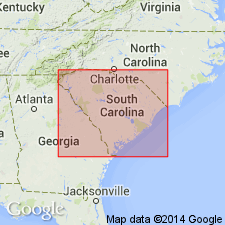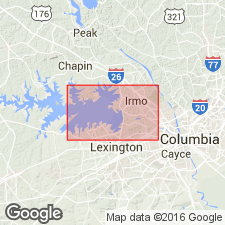
- Usage in publication:
-
- Wildhorse Branch Formation
- Modifications:
-
- Named
- Dominant lithology:
-
- Greenstone
- Phyllite
- AAPG geologic province:
-
- Piedmont-Blue Ridge province
Summary:
Wildhorse Branch Formation named in the Carolina Slate belt of central SC. Consists of greenish-gray greenstone, felsic tuffaceous phyllite, and graphitic phyllite. Thickness greater than 3000 m. Underlies Persimmon Fork Formation (new). Age is Precambrian or Cambrian.
Source: GNU records (USGS DDS-6; Reston GNULEX).

- Usage in publication:
-
- Wildhorse Branch Formation
- Modifications:
-
- Overview
- AAPG geologic province:
-
- Piedmont-Blue Ridge province
Summary:
Wildhorse Branch Formation greater than 2400 m thick in mapped area. Consists of 50 percent felsic tuff, 40 percent mafic tuffs and flows, and 10 percent pelitic sediments, mostly metamorphosed to schist. Underlies Persimmon Fork Formation and overlies unnamed quartz-microcline gneiss. No age given.
Source: GNU records (USGS DDS-6; Reston GNULEX).
For more information, please contact Nancy Stamm, Geologic Names Committee Secretary.
Asterisk (*) indicates published by U.S. Geological Survey authors.
"No current usage" (†) implies that a name has been abandoned or has fallen into disuse. Former usage and, if known, replacement name given in parentheses ( ).
Slash (/) indicates name conflicts with nomenclatural guidelines (CSN, 1933; ACSN, 1961, 1970; NACSN, 1983, 2005, 2021). May be explained within brackets ([ ]).

